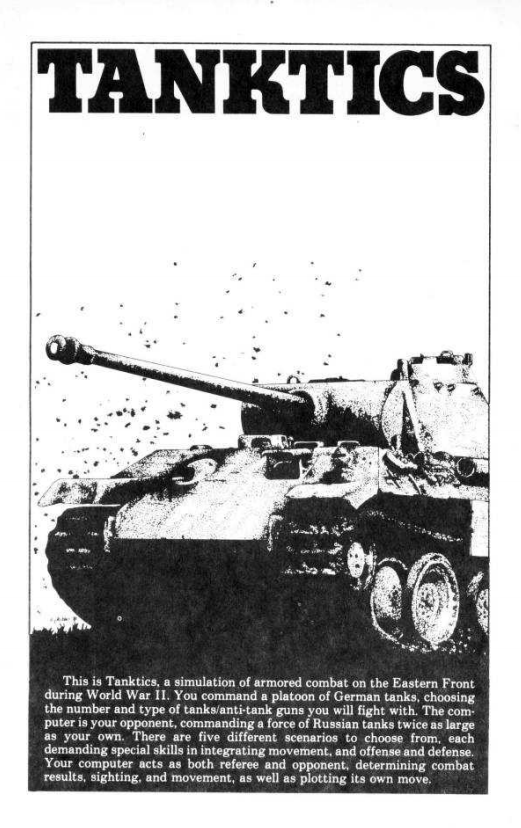
Tanktics by Chris Crawford [published later by Avalon Hill], USA
First release : 1978 on Commodore PET,
Tested on : Atari Emulator, Apple II Emulator
Total Hours Tested : 6
Average duration of a battle : 30 minutes
Difficulty: Easy (1/5)
Would recommend to a modern player : No
Would recommend to a designer : No
Final Rating: 15/100
Note that all Rating & Review posts assume that you have read the game’s AAR.
I had a lot of difficulties starting this “Review & Rating”, not only because it would be the first one, but also due to the nature of Tanktics.
I will therefore start with a seemingly unrelated personal anecdote, but bear with me. Years ago, my attention was attracted by a boardgame on sale : Great War at Sea: Jutland. I bought it, and inside there was literally hundreds of counters (840 exactly) for every single ship of every single nation of Northern Europe from 1890 to 1920. Campaigns consisted in tracking the status of every single ship active in those campaign in terms of damage, fuel level (with different rules for coal-engine and oil-engine), … Finally, you could not directly play by pushing your fleet on the strategical map – no. To simulate fog of war and imperfect communication, you had to write your orders several turns in advance.
The two times I played this game, always playing some of the easiest scenarios, my opponent and I both decided to use an Excel file to track all the parts. The management was so tedious that for one minute playing, we probably spent 4 minutes updating our Excel file.
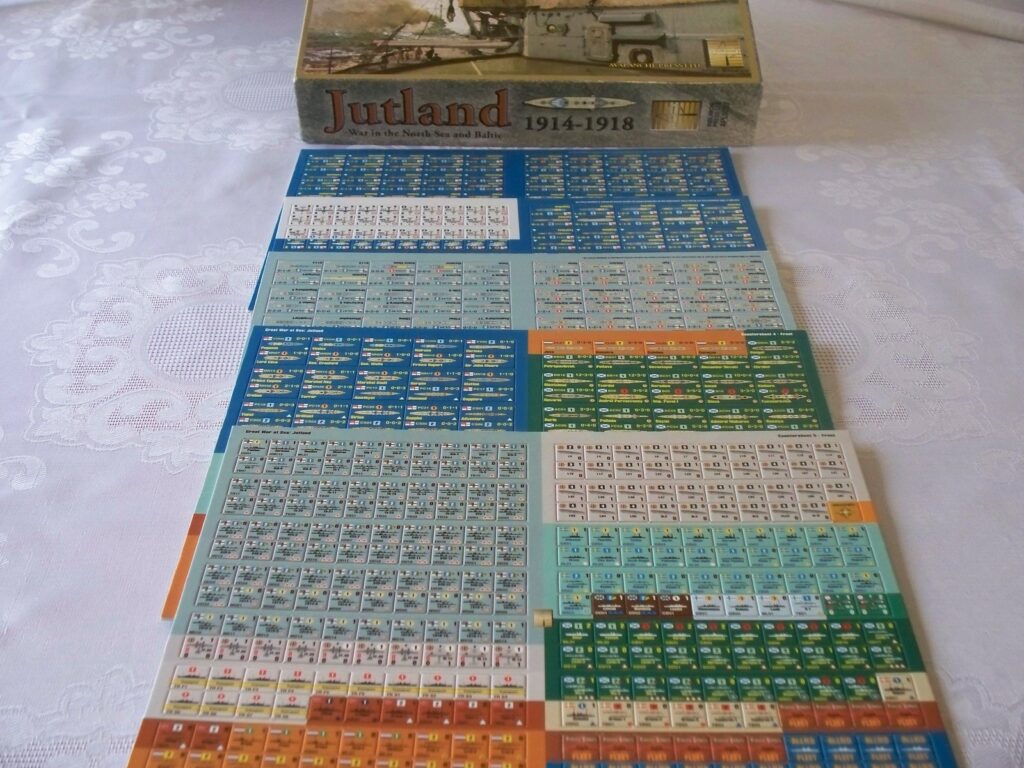
GWaT:Jutland is an extreme case, but all board wargames have this problem that a significant part of players’ time is spent not playing but refereeing. Chris Crawford was one of those who foresaw that personal computers could become “automatic referees”. In an article published in the very first issue of Computer Gaming World in 1981, he stated : “The computational power of the computer will allow it to replace the human as game executor and permit the human to concentrate on his real role of game player. In the process, combat results tables, terrain effects charts, another such impediments will be eliminated. The computer will perform more extensive and more realistic calculations to execute the same functions without the human’s intervention.” But though not mentioned in his article, in Tanktics Chris Crawford went further : not only refereeing the rules, but even hiding them from the player. But while players certainly don’t want to know the equations happening under the hood, they want to know their success chance for any action and Tanktics does not offer that – the practice of displaying “success chance” or “expected results” will come much later.
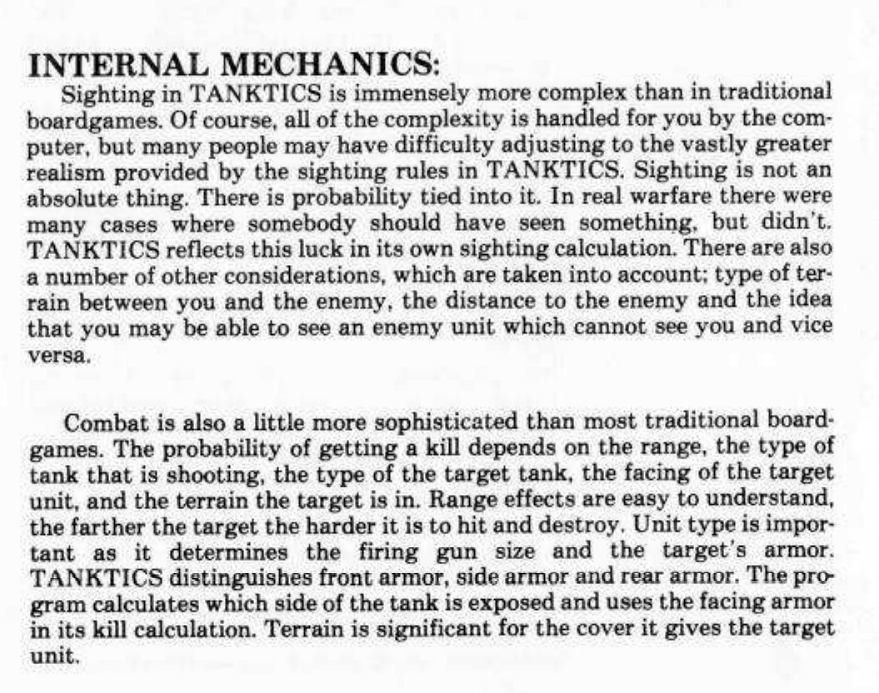
No one who tries to play Tanktics nowadays will really have the original, “real” Tanktics experience, because back then it was perfectly new, and because no one today can play with the boards and counters it was designed with. VASSAL is great, but it is a lot more fun to push a real counter on a real board than to drag and drop, right-click to orient counters on a virtual one
But I want to judge the game not for what it was, but for what it is to the modern player.
Now for the rating :
A. Settings & Aesthetics
Tanktics happens somewhere in the WW2 Eastern Front, with a small number of historical tanks. That’s more or less all there is to it as far as historicity is concerned. There is no infantry, no planes, no artillery. The combats don’t feel really believable due to the detection rules, with tanks appearing and disappearing from sight for no reason.
As for aesthetics – without the board, there is no graphics at all. It gets one point for the VASSAL. Score : 3/20
It would probably been closer to 7/20 with the original board.
B. UI , Clarity of rules and outcomes
The game has no feedback about what is happening. You don’t know what is your hit chance, you don’t know which tiles you see and which ones you don’t. When the game tells you you “missed” a tank, did you miss it because the shell passed next to hit, or did you miss it because the shell did not penetrate ? Well, you don’t know.
The game is quick to pick up and play, but given its lack of depth it is not really a feat.
There are also some other minor but irritating issues, the most critical one is not being able to cancel selection when you selected the wrong tank to move : the game will force you to give an order. Score : 2/20.
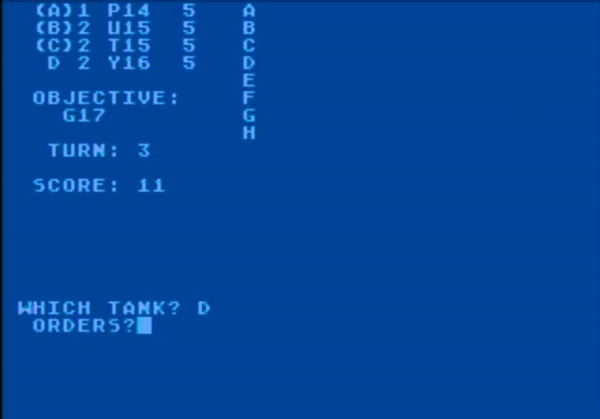
C. Systems
The game has no “high” level system – only the low level tactical one.
This only layer is extremely simple, you can only move or shoot. Detection seems very random, and there are no simple rules like “units shooting are more likely to be detected” or “units that have been detected remain detected until they move”. There is simply not much depth there. Score : 2/20
D. Scenario design & Replayability
There is not a real “scenario design” but rather 5 scenario blueprints, but two of them are against boring anti-tank guns, which leaves two defensive scenarios and the “encounter” one that feels superior to all the other ones. Choosing one’s tanks is nice, though the choice is limited (why 3 different types of anti-tank guns for a game about tanks?). The fact that all the Soviets are using the same type of tank limits freedom of design – and surprise. 3/20
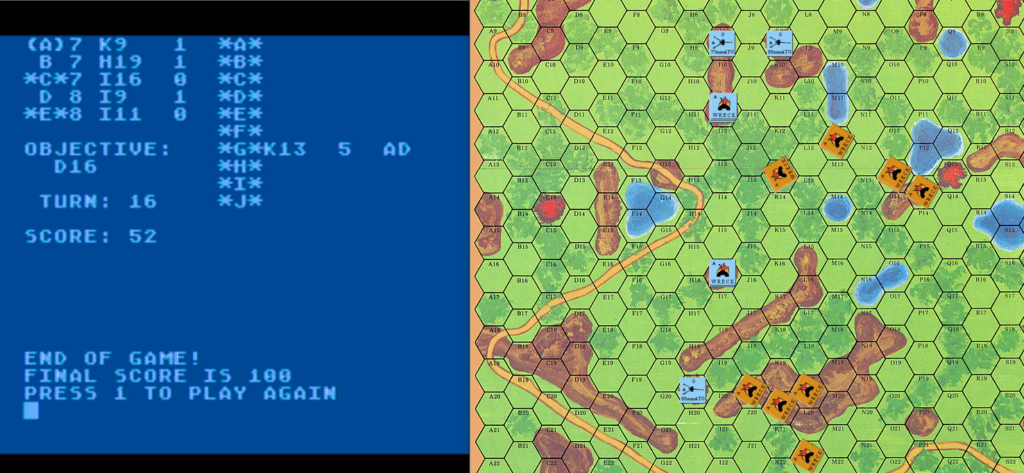
E. AI Quality & Balancing
As I showed in the After Action Report : the AI moves directly to the target and stays there, gracefully offering its flank and back. It does not even try to move in “protected” tiles like forest or rough cover. At least the game is easy to balance by giving better tanks to the Soviet side, though it may mean just waiting longer from a hidden position until a shoot connects.

As for the balancing, it is nice to be able to choose the difficulty of the game by picking some tanks for oneself or for the AI. There is a point system but it does not work very well and in particular does not take into account relative tank quality. Score : 3/20

F. Final rating and raw fun.
This gives the game an average rating of 13/100. This feels a bit harsh, as despite all its shortcomings, the game is not terrible as a quick beer and pretzel game. Though limitations became obvious very quickly, I played the first times without displeasure. The game deserves a couple bonus points for being so easy to pick-up. 15/100
Contemporary reviews
According to Wikipedia, the first video game magazines appeared in 1981 – too late for the first release of Tanktiks. I could only find two reviews after checking both English-speaking and French-speaking magazines
– One review in the February 1982 issue of the Computer Gaming World. The reviewer [Bob Proctor] found the AI lackluster, the lack of feedback for the player actions “irritating” and really did not like the rules for line of sight, but nonetheless found the game plain fun “for those of us who like a little uncertainty“. He also claims that different tanks have different “armor patterns” in the game like they do in real life, which I doubt but who knows.
– One review in the March 1984 issue of Tilt (a French magazine) stuck to a basic description of the game, giving it 2/6 for realism and 2/6 for interest.
Tanktics was a historical landmark of computer gaming, and it took barely more than 10 years to fall into obsolescence and to be regarded as a curiosity rather than a wargame. See for instance its rating and description in a retrospective of WW2 wargames published by Computer Gaming World in late 1991, also the last non-Internet review I could ever find on the game : Rating : “Marginal+” – “Essentially a computer-assisted boardgame.”
4 Comments
> Chris Crawford was one of those who foresaw that personal computers could become “automatic referees”
Interestingly, it’s the first time I heard the idea of using the computer as referee in those huge-ass board games, but that’s not really surprising.
It makes sense when you think that the early computers were seen as giant calculators devoid of any real graphical interface.
In a sort of backward way, you can see this idea having made a comeback with the online RPG tools you see nowadays, where you have a computer program handling all the dice rolls for the players.
Just want to know I’m pretty excited to see this series. I was wistfully hoping for a Wargames Addict not long ago and lo and behold!
Good luck, and feel free to ping if emulators give you any headaches.
Thanks for that ! I will do it, fortunately it looks like most wargames were released on either Atari or Apple II, which are easy to emulate. I did try to test Invasion Orion on TRS-80 but failed spectacularly – not eager to HAVE to test a game on TRS-80 (for Invasion Orion it would have been a bonus).